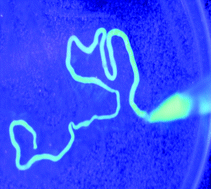Supramolecular hydrogels derived from silver ion-mediated self-assembly of 5′-guanosine monophosphate†
Abstract
We describe the preparation and properties of supramolecular hydrogels produced by spontaneous self-association of

* Corresponding authors
a
Centre for Organized Matter Chemistry, School of Chemistry, University of Bristol, Bristol, UK
E-mail:
avinash.patil@bris.ac.uk, s.mann@bris.ac.uk
b
Department of Chemical Sciences, Indian Institute of Science Education and Research Kolkata, Mohanpur, Nadia, West Bengal, India
E-mail:
jyotidash@iiserkol.ac.in
We describe the preparation and properties of supramolecular hydrogels produced by spontaneous self-association of

 Please wait while we load your content...
Something went wrong. Try again?
Please wait while we load your content...
Something went wrong. Try again?
J. Dash, A. J. Patil, R. N. Das, F. L. Dowdall and S. Mann, Soft Matter, 2011, 7, 8120 DOI: 10.1039/C1SM05839H
To request permission to reproduce material from this article, please go to the Copyright Clearance Center request page.
If you are an author contributing to an RSC publication, you do not need to request permission provided correct acknowledgement is given.
If you are the author of this article, you do not need to request permission to reproduce figures and diagrams provided correct acknowledgement is given. If you want to reproduce the whole article in a third-party publication (excluding your thesis/dissertation for which permission is not required) please go to the Copyright Clearance Center request page.
Read more about how to correctly acknowledge RSC content.
 Fetching data from CrossRef.
Fetching data from CrossRef.
This may take some time to load.
Loading related content
